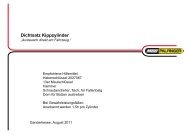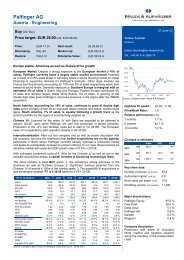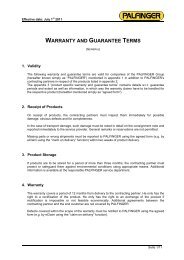palfinger at a glance
palfinger at a glance
palfinger at a glance
Create successful ePaper yourself
Turn your PDF publications into a flip-book with our unique Google optimized e-Paper software.
Industry Review<br />
Consolid<strong>at</strong>ed Management Report / Market Review<br />
> search Print<br />
Industry Review<br />
Due to the fact th<strong>at</strong> PALFINGER has a diversified product portfolio, the Company’s products are used<br />
in a variety of industries. In addition to the construction industry, transport and haulage industries,<br />
railway infrastructure, timber and agriculture as well as the recycling industry, both wind energy and<br />
marine systems have also been relevant customer industries for PALFINGER since 2010.<br />
Construction industry<br />
Although the situ<strong>at</strong>ion improved slightly in the European construction industry in early 2011, an<br />
economic downturn was observed as the year went on. In most European countries, forecasts for<br />
the construction industry had to be revised downwards in the second half of 2011, as the debt crisis<br />
quickly affected the entire industry. Portugal, Spain, Gre<strong>at</strong> Britain and Ireland were hit particularly<br />
hard. The Eastern European countries also failed to live up to expect<strong>at</strong>ions as growth markets. The<br />
only exception was Poland, which displayed dynamic development until the end of the reporting<br />
period. Construction activities also rose slightly in Russia, boosted by large-scale projects particularly<br />
in connection with the prepar<strong>at</strong>ions for the Winter Olympic Games 2014 in Sochi and the World<br />
Football Championships 2018.<br />
Economic development is reflected<br />
in the construction industry.<br />
According to Euroconstruct, a heavy slump in the building industry in Europe was prevented primarily<br />
by the anti-recession measures taken by the public sector in civil engineering and in the redevelopment<br />
sector. Based on the economic outlook for the 2012 financial year, activity in the European<br />
construction industry is expected to slow down even further. From 2013 onwards, more and more<br />
stimuli are expected to come from the construction of new buildings so th<strong>at</strong>, for the first time after<br />
having posted neg<strong>at</strong>ive figures for five consecutive years, sustainable recovery should be feasible.<br />
According to the N<strong>at</strong>ional Associ<strong>at</strong>ion of Home Builders (NAHB), the housing market in the USA<br />
stabilized in 2010 and recorded a plus for the first time after four years marked by declines. For the<br />
year 2011 as a whole, an increase of approx. 1 per cent to a total of 592,000 started construction<br />
projects is forecast. In 2012, recovery of the US housing market is predicted to acceler<strong>at</strong>e further to<br />
approx. +15 per cent and in 2013 a figure of more than 900,000 housing units should be <strong>at</strong>tained.<br />
As promising as these increases may sound, not even half of the level achieved in 2005 will be<br />
reached in 2013 if the assumed targets are met.<br />
In South America, an upward trend is expected, primarily in Brazil, due to investments in<br />
infrastructure for the World Football Championships 2014 and the Summer Olympic Games 2016.<br />
Asia remains the leader in the field of housing, structural engineering and civil engineering. Solid<br />
growth is to be expected, first and foremost in China and India; the Chinese five-year plan provides<br />
for the construction of approx. 32 million new priv<strong>at</strong>e residences by 2015. Nevertheless, even these<br />
markets will not be spared the effects of the macro-economic developments in the global market.<br />
According to D<strong>at</strong>amonitor’s assessment, the structural engineering and civil engineering sectors in<br />
Asia are going to show an average growth r<strong>at</strong>e of approx. 7 per cent in the next years.<br />
In the developed markets, ecological and social aspects have been increasingly taken into consider<strong>at</strong>ion<br />
in the design of new buildings and sustainability certific<strong>at</strong>ions have gained acceptance,<br />
primarily for top-quality buildings. For the time being, however, such certific<strong>at</strong>ions are associ<strong>at</strong>ed<br />
exclusively with the quality of finished buildings but not with the construction process itself. This<br />
means th<strong>at</strong> construction companies are not yet required to comply with stricter regul<strong>at</strong>ions in<br />
connection with energy efficiency, noise prevention and safety.<br />
46 <strong>palfinger</strong> Annual Report 2011

















